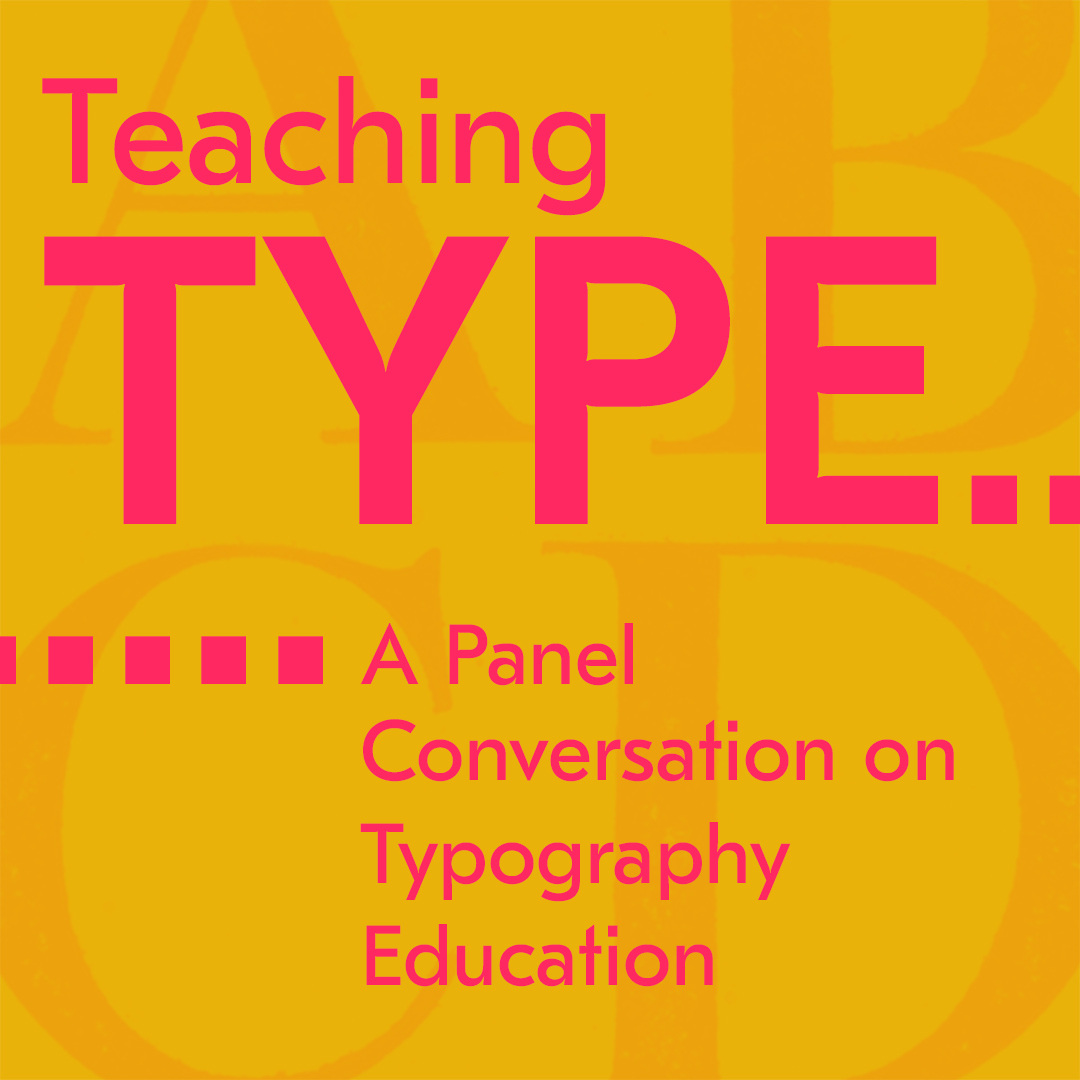Read the interview with Thomas Jockin of Type Thursday, Liz Deluna and Mark Zurolo.
Tag: typography
The Avant-Garde of Iranian Graphic Design
Pouya Jahanshahi
Assistant Professor of Graphic Design
Department of Art, Graphic Design and Art History
Oklahoma State University
The advent of the Apple Macintosh brought about a rapid flow of technological change which affected almost every part of visual communication arena, in one way or another. Since the start of this digital revolution, most graphic design communities around the world succeeded in maintaining their national identities, while implementing the technological changes into their industries, hence joining the global world of graphic design. However, because of challenges related to mark-making and the specifics of calligraphic-based scripts, Iranian typography – and by extension graphic design – struggled to maintain and its rich historic traditions and visual aesthetics, as Perso-Arabic characters necessitated a process of digitization for use in dominant graphic software applications of the time.
Furthermore, during this global digital revolution, various socio-political and technological circumstances resulted in the isolation of the Iranian graphic design arena from the global culture, for more than a decade. More recently, the dusk of 20th-century, brought forth an impenitent generation of innovative thinkers and designers, keen to define their lost identity. Through inwards nationalistic perspectives as well as technical and conceptual innovations, this generation made giant leaps and set forth a trajectory toward joining the global graphic design arena.
This research delves into the nuanced traditions of Iranian calligraphy and the struggle for its adaption to western printing technologies. Specifically, it focuses on the process, and the eventual arrival of what may be referred to as a hybrid graphic form – one comprising of the traditional eastern calligraphic forms and nuances, merged with the characteristics found in western typographic structures and letterform design.
This research was presented at the Design Incubation Colloquium 3.2: Parsons Integrated Design on Thursday, Feb 16, 2017.Teaching Type: A Panel Conversation on Typography Education
Educators will discuss innovations, challenges and best practices for teaching typography.
As a mainstay of design, typography is a corner stone of most degree programs in visual communication design. Still questions abound. How and where typography is taught is as varied as its use in design applications. We invite you to join fellow educators in a conversation which will focus on how, where and when we teach typography. Our panelists will explore the role of typography in the continuum of design education and identify areas where traditional programs experience shortcomings and challenges. We will ask what fundamental skills should be taught and whether the way we are teaching typography needs to change in a screen-based world? Finally, we will ask the audience to participate in identifying specific skill sets and methodologies which should be part of type-centric design curriculum in the 21st Century.
The conversation will be moderated by Doug Clouse, President of TDC and Principal at The Graphics Office and Liz DeLuna, Associate Professor of Design at St. John’s University.
Type Directors Club
347 West 36th Street
Suite 603
New York, NY 10018
Saturday, April 1, 2017
2pm–5pm
Moderators
Liz DeLuna
Associate Professor of Design
St. John’s University
Doug Clouse
President, Type Directors Club
Principal, The Graphics Office
Panelists
Thomas Jockin
Founder of TypeThursday
Adjunct Professor
Queen’s College, CUNY
and Fashion Institute of Technology, SUNY
Amy Papaelias
Assistant Professor
Graphic Design
SUNY New Paltz
Co-founder of Alphabettes.org
John Gambell
Senior Critic
Yale School of Art
Yale University Printer
Juliette Cezzar
Designer, Writer
Assistant Professor
Communication Design
Parsons School of Design, The New School
Hosted by the Type Directors Club.
You Look Like The Right Type
Mark Addison Smith
Assistant Professor
Electronic Design and Multimedia
The City College of New York, CUNY
An illustration manifests “thought” through the viewer’s decoding of visual-based representation—be it text-based, image-based, or a combination of both. Logocentrism holds that original thought generates a need for spoken communication and, in turn, speech generates a need for writing. In a daily ritual since 2008, I redraw exact-dialogue fragments of overheard conversations as 7×11-inch India ink illustrations (combining direct-quote text with visual and tonal embellishment) and combine the single illustrations into larger, theme-based conversations between people who have never met or exchanged words. When amassed together as modular narratives, my black and white drawings—collectively titled You Look Like The Right Type—start having grayscale conversations with one another across time, place, age, and gender (the who, what, when, where, why, and how of journalistic-narrative documentation). And the audience, as interlocutor, triangulates the conversation by reading that which was once spoken and making their own non-linear, grayscale associations between text, image, and completion of what’s left unsaid. Thus, original thought emerges not only through my reinterpretation of other voices, but also through z-axis, non-linear readability (or, Scott McCloud’s “infinite canvas”).
In his 1967 text, Of Grammatology, Derrida argues for a definition of grammatology in which written language is not derivative of spoken language, but, rather, the two become independent, legitimate signifiers for original thought. Thus, the written word (including text-based illustration) can be understood from a stance as comprehensive as the spoken word. Within my You Look Like The Right Type series, I’ve been archiving daily conversation fragments as black and white illustrations since 2008 in a ritualistic effort to not only bring permanence to the spoken form, but also to manifest original thought—via the recycled thoughts of others—within illustrated type-and-image works on paper. In keeping with the principles outlined in Derrida’s text, I argue—using my archive of 3,000+ illustrations coupled with theories of documentary-style narrative, montage editing, logocentrism, and the z-axis of non-linear comic paneling—that spoken language and written language are autonomous and equal forms of communication, feeding off of one another to generate new storytelling.
An archive of these daily works can be found at YouLookLikeTheRightType.com.
This research was presented at the Design Incubation Colloquium 2.5: Fashion Institute of Technology (FIT) on Saturday, March 12, 2016.Never Use Futura
Douglas Thomas
MFA Candidate in Graphic Design
Maryland Institute College of Art
Never Use Futura explores the cultural history and uses of the typeface Futura, one of the foundational typefaces of modern graphic design. The project is a playful yet passionate rebuttal to the perceived dominance of Helvetica as the typeface of modern design. Futura not only went to the Moon, and advertised for countless companies, it has been the face of German communism, British conservatism, and American politicians of all stripes. Futura became one of the most popular and iconic designs of the twentieth century in spite of a world-wide economic depression, trade embargoes, political boycotts, government prohibitions, and many knockoffs and competitors.
The project chronicles the cultural history witnessed (and recorded) by the typeface Futura from its avant-garde beginnings to its mid-century triumph and its present-day nostalgic, critical, and forward-looking uses. Even now, Futura remains the iconic typeface of tomorrow. Countless designers have used the type to signal progress and promise change but also to critique capitalism and subvert authority. Futura has sold millions of people their dreams and hopes (and shoes and cars), and ever since the Apollo missions it has embodied our cosmic aspirations. The story of Futura is more than a story of geometric shapes and Paul Renner, it is the secret history of modern public life.
This research was presented at the Design Incubation Colloquium 2.4: CAA Conference 2016, Washington, DC on Wednesday, February 3, 2016.Design Incubation Colloquium 2.4: CAA Conference 2016, Washington, DC
Wednesday, February 3, 2016
Time: 9:30am – 12:00pm
Location: Hoover, Mezzanine Level, Marriott Hotel
In collaboration with CAA Task Force on Design at the 104th Annual Conference in Washington, DC.
Chairs: Steven McCarthy, University of Minnesota; Aaris Sherin, St. John’s University
Abstract submission deadline: January 17, 2016. Email abstracts for peer review to submissions@designincubation.com
Open to all 104th Annual Conference, Washington, DC attendees.
Presentations
Teaching Timeless Theory in Interactive Design through a Multidisciplinary Approach
James Pannafino
Associate Professor
Interactive and Graphic Design
Art and Design Department
Millersville University
Who Does This Internet Artwork Belong To? A Study on Art Appropriation and Youth Identity in a Digital Age
Laura Scherling
GreenspaceNYC, Co-founder
The New School, Design Lead
Teachers College,
Columbia University, Doctoral student
Conscious Interventions With The Personal Beasties Breathing Mobile App
Paula Murgia
Co-Founder Personal Beasties Group, LLC
Marianna Trofimova
Adjunct Professor
Communication Design Department
New York City College of Technology
City University of New York
Principal at Marianna Trofimova Design
A Plan for a National Communication Design Educator Award
Steven McCarthy
Professor
College of Design
University of Minnesota
Never Use Futura
Douglas Thomas
MFA Candidate in Graphic Design
Maryland Institute College of Art
Commute 2 Brooklyn: Visual Exploration Along Interstate 278
Mary Ann Biehl
Associate Professor
Communication Design
New York City College of Technology, CUNY
Maria Giuliani
Associate Professor
Communication Design
New York City College of Technology, CUNY
Alterpodium: Performing Disability
Amanda Cachia
PhD Candidate, Art History, Theory & Criticism
Department of Visual Arts, University of California San Diego
Design Practice Intervention: Experimental Approaches to Mapping Different Data
Rachele Riley
Assistant Professor
University of Illinois at Urbana-Champaign
Color, A “Conflict Mineral”
Grace Moon
Adjunct Professor
Graphic Design, Dept of Art
Queens College, CUNY
The Art of Mutable Mergers: Collaborations Between Designers, Artists, Curators, and the Plastics Industry, 1960 – 74
Grace Converse
Adjunct Instructor of Art History
Purchase College, SUNY
St. Joseph’s College, Brooklyn
Font Design: Caribbean Archeology Inspired Symbols
Maria Giuliani
Associate Professor
Communication Design
New York City College of Technology
The Taíno Indians resided on the island of what is today known as Puerto Rico. Hundreds of petroglyphs or images carved into stone have been found here and in many of the other Caribbean islands.
Contrary to other known archeological glyphs like the Egyptian hieroglyphs or Mayan scripts, these are not part of a written language or system, but rather isolated images with multiple meanings. Many of these images seem to be literal, while others are definitely more abstract, perhaps used as part of rituals and festivities.
These symbols have become a great part of the Puerto Rican culture and representative of its indigenous heritage. Today they are often used in the arts, fashion, crafts, and are an integral part of education. I started my research and found books on the subject, websites with downloadable jpegs, and even a Taíno inspired display typeface (letters), but not an existing font that purely depicted the symbols. I wanted to create an easily accessible version of these. By transforming these symbols into a font, they can easily be used as a traditional dingbat, a decoration, paragraph separators or even stand alone as a simple illustration.
I decided to design a symbol-font based and inspired by these stone drawings. My presentation will show the progression of my work from pencil and ink to Adobe Illustrator to the Font Editor “Glyphs”.
Re-Defining Reading
Laura Franz
Professor, Design Department
Head, Graphic Design Option (Major)
College of Visual and Performing Arts, UMass Dartmouth
For decades, critics have predicted the end of the written word: “No one reads anymore!
No one writes anymore!” Yet from birth certificates to gravestones, from T-shirts to text messaging, the written word—and thus reading—is woven into the fabric of our everyday lives.
Throughout history, we have used the written word to record and preserve who we are and what we care about: possessions, laws, commitment, ideas, and memories. Words and characters, once impressed in clay, written on papyrus, and printed with ink, are now manifest in pixels of light.
The use of text messaging for casual conversation has exploded, surpassing phone conversation as the communication method of choice—suggesting that our personal connection to reading and writing continues to thrive.
People may not participate in sustained reading the way they used to (or the way we think they used to), but people read. They text, tweet, and post on Facebook and Instagram. They search for things they need or want to know. They get lost in stories.
People read what is important to them. If we define reading only as a sustained and literary activity, if we acknowledge only one kind of reading, then we measure ourselves against a fabricated truth. We ignore the actual activity and exclude people’s needs and desires.
In Re-Defining Reading I illustrate three common approaches to reading; reflect on how re-defining reading has informed how I use and teach traditional typographic theories and practices within the context of web design; and show how a subtle shift—from user to reader—can help us adapt knowledge from the old (print) to serve the new (web).
The truth is there are different ways to read, and they are all valid and important. As designers, we can support them all.
This research was presented at the Design Incubation Colloquium 1.5: Rhode Island School of Design on Saturday, March 7, 2015.The Queer Writing on the Bathroom Wall
Mark Addison Smith, Assistant Professor
Electronic Design and Multimedia
The City College of New York
The Queer Writing on the Bathroom Wall documents my typographic and theoretical process of discovering an instance of homophobic graffiti—gay fagget fucker die you know it’s a truck driver—within a midwestern truck stop men’s bathroom, translating the author’s letterforms into a coded-language system for the targeted queer community, and using my newly designed typography to “talk back” against and eradicate the source hate.
Cross-referencing design theory lenses of Sassure’s semiotics, Dunn’s graphic signal, and Meggs’ metasymbol against queer theory lenses of Kinsey’s bathroom, Foucault’s confession, and Munoz’s disidentification, my role as communication designer existed as analyst and visual-activist. I reappropriated the strokes, angles, and terminals of the graffiti author’s non-repeating 20 letterforms into a complete 52-character uppercase and lowercase alphabet based upon his writing style. Through a process of mirroring and overlay, I arranged these letterforms on top of each other to design a homosexualized alphabet of same-letter ligatures, or, same-sex letters having sex. I returned to the original bathroom stall and deployed my own response, let’s face it we’re all queer (a graffiti battle-cry from the 1970s New York City queer revolution), directly on top of his graffiti—to both reference the source of my redesigned typeface and provide the audience with a translation-key—in an act of eradication and reclamation. Through textual manipulation, I’m hoping to analyze the emotional baggage carried within the individual strokes of the author’s handwritten language, to uncover the latent homosexuality within his written homophobia, and to generate a letterform-based code in which the author cannot answer back.
Desire teaches us that the more something is kept as a secret, the more we are driven to uncover and interpret it. Design allows us to interpret it. Such is the nature of Foucault’s confession, and our desire—as interlocutor—to translate and assimilate…and, from a design perspective, to ultimately visualize identity-formation and reverse-discourse empowerment.
——-
This research will be featured as a chapter in Routledge’s Diversity and Design: Understanding Hidden Consequences, to be released in 2016.
This research was presented at the Design Incubation Colloquium 1.5: Rhode Island School of Design on Saturday, March 7, 2015.Bequeath(ed) Type
Liz DeLuna
Associate Professor of Graphic Design
Department of Art and Design
St. John’s University
Cemeteries provide a landscape rich in social, cultural and aesthetic history. They house the dead, but the grave markers designed and crafted by the living, leave a legacy of traditions, styles and preferences. This is especially evident in the variety of lettering styles that are particular to time periods and regions. Some gravestone carvers were more adventurous, others more conventional, and some eclectic, idiosyncratic and seemingly accidental. This lecture explores the process involved in creating a digital type family based on 18th century gravestone inscriptions and includes an examination of the original inspiration, visual exploration and primary research, as well as the use of relevant design technologies.
This research was presented at the Design Incubation Colloquium 1.5: Rhode Island School of Design on Saturday, March 7, 2015.

